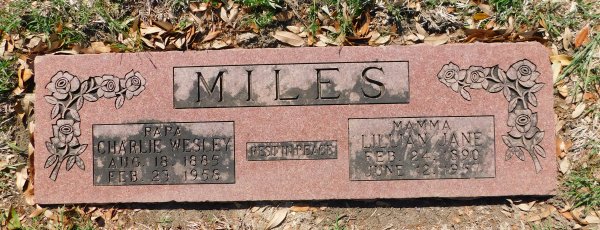|
The Miles Family By Steven R. Butler
The Miles Family A Brief Biography of
My paternal grandfather, Charles W. Miles, was born on August 18, 1885 in Franklin County, Tennessee. He was the only known child of John W. Miles and his third wife, Margaret Elizabeth Hodge Miles. In December 1885, when Charlie was only four months old, his father, John W. Miles, abandoned him and his mother, and ran away to Alabama with Mary Alice Hefner, a woman with whom he had been consorting during his marriage to his second wife, Kate, and also during his marriage to Charlie's mother, Margaret. When John W. Miles left, without giving a reason or any warning, he had already fathered three children with Mary Alice, including one that was born in September 1885, just a month after Charlie. In Alabama, J.W. and Mary Alice had two more children before moving to Texas in 1893, where they settled first in Collin County, and then Hunt County. They also had four more children, for a total of nine. Whether or not Charlie ever met any of them is unknown. In 1892, Charlie's mother was granted a divorce from her absent husband. Soon after, in 1893, she married Seaborn E. Jones, by whom she already had two daughters, Daisy and Nettie. Margaret and her second husband, S. E. Jones, are listed in the 1900 federal census for Franklin County, Tennessee, with five children in the household. For some inexplicable reason, Margaret's eldest son, Charlie Miles, is listed in the same census as the "adopted son" of Benjamin W. Rhoton, Jr. and his wife Laura Farris Rhoton. The nature of the Rhotons' relationship to Charlie Miles, if any, is unknown, but it should be noted that when John W. Miles married Margaret E. Hodge in 1884, his fellow bondsman was John T. Farris, brother of Laura Farris Rhoton and brother-in-law of Benjamin W. Rhoton, so clearly the two families had ties of friendship, if not family ties.
Sometime between 1900 and 1908, Charlie Miles left Franklin County, Tennessee and went to live in Dallas County, Texas. How he made the journey, and when, and his reason for doing so are all unknown, but I speculate that he came to Texas because he was offered a job in the general store that Benjamin W. Rhoton's brother, Junius Tribble Rhoton, was then operating in the little community of Audelia, located three miles south of Richardson, Texas, at the present-day intersection of Forest Lane and Audelia Road. Until 1900, Rhoton was also Audelia's postmaster. Charlie may have also been encouraged to settle in Dallas County by the fact that two of his stepbrothers, Charlie T. Jones and Jesse H. Jones were then farming in the vicinity of the town of Garland, Texas, not far from both Richardson and Audelia. Sometime after he arrived in Texas, Charlie Miles somehow became acquainted with Lillian Jane Dalton, daughter of James Franklin Dalton, a farmer who lived near the tiny community of Vickery, located a few miles south of Richardson. On September 27, 1908, Charlie and Lillian were married by the Reverend George Truett, pastor of the First Baptist Church in Dallas. A report of the wedding in the Dallas Morning News remarked that the newlyweds would be making their home in Richardson. The precise location of their rented home has been lost to history, but Richardson was a very small place then, and it was almost certainly somewhere within two or three blocks of the intersection of present-day Main Street/Belt Line Road and Greenville Avenue.
Whether or not Charlie ever knew his father was living only about 30 miles or so north, in Collin and Hunt counties, until John W. Miles' death in 1928, is unknown. During the first two decades of the twentieth century, which included the dozen or so years that Charlie lived in Richardson, some important developments occurred in the community. In 1901, the Richardson Telephone Company began service and on October 12, 1901, the first issue of Sam Harben's newspaper, The Richardson Echo, was published. In 1905, the Citizens State Bank opened for business at present-day 111 East Main Street (then known as Smith Street). In April that same year, there was some momentary excitement when President Theodore Roosevelt passed through town on his special presidential train, "The Rocket." Stopping briefly at the depot, the Houston & Texas Central Railway had built on the west side of the tracks in 1873, "T.R." or "Teddy" as he was popularly known, gave a short speech before "The Rocket" sped on south to Dallas, where the President was met by a much larger crowd and then, following a much longer speech than the one he'd given in Richardson, feted at a banquet at the Oriental Hotel. But that's not all. In 1907, the Houston & Texas Central tore down the old depot which had been built in 1873, and then constructed a new one on the east side of the tracks, north of Smith Street, opposite the dry goods store run by Thompson and Son. The following year, the Texas Traction Company built an electric Interurban line from Dallas to Denison, with Richardson as one of the stops. In 1909, they erected a small brick depot across the street from where the original H.&T.C. depot had stood. A few years later, the Texas Traction Company was bought out by the Texas Electric Railway, which continued to operate the Interurban line until December 31, 1948. According to an "Early History of Richardson," published in The Richardson Echo in 1950, sometime during the first decade of the twentieth century, Charlie Miles operated a livery stable owned by Fred Farrell (son of blacksmith James P. Farrell), which was located "on Central [street, not expressway] and West Main known as the onion dock owned by the Texas Electric Ry. where heavy freight was handled." According to the same article, "Mr. Farrell kept horses and buggies to rent and a place to keep stock when folks came to town and their horse or team while they went to Dallas or Plano by train." How long Charlie held this job, and precisely when, was not mentioned, but The Echo did say this: As "automobiles began to take [over] the country," Farrell sold the business to Luther Terry and John Robinson, who in turn sold out to the Texas Electric Railway Unfortunately, although there is no reason to doubt that Charlie Miles once operated a livery stable for its owner in early twentieth century Richardson, there are some unavoidable facts that raise questions, such as who did he actually work for? As it happened, Fred Farrell and Charlie Miles were almost exactly the same age. Fred was born in July 1885 and Charlie in August. This make it more likely that Fred's father, James P. Farrell, a blacksmith by trade, is the one who owned the livery stable and therefore employed Charlie, and indeed it would seem so in light of a deed recorded in Dallas County, Texas Deed Book 272, pp.474-5, which shows that on February 13, 1893, James P. Farrell bought lots 2, 3, and 4 in Block 16 in the town of Richardson, which both photographs and early maps of Richardson show was the location, more or less, of the "onion dock" mentioned in the article. But there's a problem: On October 31, 1896, James P. Farrell sold lots 2, 3, and 4 in Block 16 to J. I. (James Ira) Huffines. This occurred when Charlie was an eleven-year-old boy still living in Tennessee. In 1899, Huffhines sold that property to a kinsman, E. N. Huffhines, who in turn sold it to John Huffhines, on November 9, 1901, and then, on May 15, 1902, John Huffhines sold lot 2 of Block 16 to F. C. Callier, Jr. while retaining, apparently, ownership of lots 3 and 4. In the meantime, on December 12, 1907, when he was twenty-two years of age, Fred Farrell (along with his wife, Myra) purchased lots 7 and 8 in Block 17, which is close to the spot where the town's livery stable is supposed to have stood. However, photographs of that area show a house, not a business, at this location. Furthermore, Fred did not hold on to this property very long, selling it on March 19, 1908, not to Luther Terry and John Robinson, but rather, to a man named D. P. Kirby and his wife. So did he operate a livery stable on this site. Probably not. Interestingly, a map that was published in The Richardson Recorder (a publication of the Richardson Historical Society) in 1982 shows the town's livery stable located on the northwest corner of present-day West Main and Interurban Street, which corresponds to lot 1, Block 16 of the original town map. As it happens, Fred Farrell purchased that very same lot, in February 1914, from Mrs. Birdie Kerr. However, he sold it less than a year later to Mrs. E. T. Drygould, on or about January 2, 1915. This means that he may have owned the town's livery table for about eleven months. But even if he did, it's still unlikely that Charlie Miles worked for him because by that time, Charlie had gone on to become a road builder for Dallas County. This leaves us again with the question: Whose livery stable did Charlie Miles operate? Answer: We don't know, but it almost certainly wasn't Fred Farrell's. What about that onion dock? From all appearances, it wasn't built before June 25, 1928, when the Texas Electric Railway bought lots 2, 3, and 4 in Block 16 from the Texas Cotton Oil Company, lot 1, Block 16 from the Citizens State Bank, and lots 5-10, Block 16, from W. C. Watson and his wife. This meant the Interurban company owned the entire eastern half of Block 16. What all this also means is that in keeping with many similar instances, someone made mistakes when attempting to make a record of Richardson's history. They are still doing it today! The 1910 federal census for Justice Precinct 2 of Dallas County, Texas shows that Charlie Miles, his wife Lillian, and their one-year-old daughter Willie Mae, who was born in Richardson on August 1, 1909, lived in rented a house in Richardson. Their nearest neighbors included members of the Blewitt and Huffhines families, both of which were prominent in Richardson at the time. Future Richardson Mayor Kit C. Floyd also lived nearby. The 1910 census shows that Charlie's occupation was "farm laborer," although it's not known who employed him. On July 6, 1911, Charlie and Lillian's second child, Lorene Marguerite Miles, was born in Richardson. When their third and last child (and only son), Roderick Vernon Wesley Miles, was born in Richardson on March 18, 1913, Charlie's occupation was given on the birth certificate as "road laborer." Although automobiles had been manufactured and sold in the United States since the mid-1890s, it was not until prices began to go down in the second decade of the twentieth century that automobile sales correspondingly increased. This growth in automobile ownership led to a subsequent demand for good roads, and in Dallas County, Texas, Charlie Miles was there at the very beginning of a road-building boom that continued unabated throughout the first half of the twentieth century. In the meantime, Richardson continued to grow and change in a number of small ways. In 1911, for instance, the Harben brothers and their father, Dr. Raymond Harben, had a one-story brick building constructed to replace the wood frame building which had housed Harben's Drugstore, a Smith Street (now East Main) establishment, since 1901, and in 1912-1913, electricity became available after an enterprising entrepreneur named G. I. Wilcox, built a power plant in town. Indoor plumbing would have to wait, however, until 1926. Until then, citizens had to make do with wells that sometimes ran dry, and outhouses. Bathing was usually a once-a-week event and if you didn't have your own tub, you could take a bath in the back of Newt Harris's barber shop on Smith Street, directly across from the Citizens State Bank and Harben's Drugstore, which were almost certainly familiar sights to members of the Miles family.
During the decade or more that Charlie Miles and his family resided in Richardson, Texas, some remarkable things were happening there. Although the town didn't look like much (see photo below), it was expanding in both land size and population as town lots in new additions became available, although apparently Charlie wasn't making enough money to buy any property. In all likelihood, Charlie and his family lived only a short walk from Smith Street (now East Main) where all the stores were located. They almost certainly shopped at McKamy and Reddick's grocery store, or Jess and Oliver Harben's grocery store, and also at Sam Harben's drugstore. For a cool glass of lemonade or a Coca Cola they would have stopped by Brack Lotheridge's refreshment stand. If Charlie had a bank account it would almost certaialy have been with the new Citizen's State Bank and it's near certainty that when he had his haircut, barber Newt Harris took care of it. We know that Charlie subscribed to the local newspaper, The Richardson Echo. In those days there were no house numbers and mail had to be picked up from Mrs. Allen's post office on Central Street (now Texas Street). Whenever anyone wrote to Charlie, like his half-brother Wheeler Jones, who lived in Fort Cobb, Oklahoma, he simply addressed it: "Charlie Miles, Richardson, Texas."
In 1908, Richardson became a stop on the Texas Traction Company's Interurban line, making travel to Dallas more frequent and cheaper than by train. Residents could also travel on the Interurban as far north as Dension.
Although Richardson was growing, sometime between the birth of Roderick in 1913 and Charlie's registration with the draft board on September 18, 1918, the Miles family decided to leave. For a short time, they lived in or near the rural community of Vickery, located near the present-day intersection of Greenville Avenue and Walnut Hill Lane, where Charlie's in-laws, the Daltons, resided. On his draft registration card, Charlie not only included his middle name, Wesley, in his signature, but also gave his occupation as "Road Supervisor" rather than "laborer." The following year, the Miles family moved to East Dallas, where they rented a house at 1426 Rowan Avenue. In 1920, a carpenter/contractor named Herman H. Butler, his wife Alice, and their three children-Henry, Margaret, and Ruth-purchased the house next door, at 1428 (later renumbered 1432) Rowan Avenue.
Because they were all nearly the same age, and lived next door to one another, it seems only natural that the Miles children and the Butler children would become playmates, a fact that is confirmed by a 1925 feature article in the Dallas Journal, which included a photo of some of the Rowan Avenue neighborhood children, in which they are identified by name and address. In the photo, ten-year-old Ruth Butler is seen standing directly in front of slightly-older Willie Mae Miles. Roderick Miles, holding a horse by the bridle, is also seen in the photo.
On Wednesday, December 21, 1927, Alice Tate Butler gave birth to a child fathered by Charlie Miles. Whether Alice's husband, Herman, believed the child to be his own or if he knew or even suspected that it wasn't is unknown. Nor is it known whether Charlie Miles knew the child to be his, or if he only suspected that it might be. In any event, apparently by mutual agreement, either spoken or unspoken, Charlie and Alice decided to let their friends, family, and neighbors believe that the baby boy to which Alice had just given birth was her husband's and consequently, he was named Raymond Joe Butler, taking the surname of the man--Herman H. Butler--who in effect adopted the boy as his own, even if he did not do so knowingly. (See photo of Raymond at age 3 months, below.)
Following the birth of Raymond, the Miles family continued to live at 1426 Rowan Avenue for two more years, leading one to wonder if during all that time Charlie ever had any interaction of any kind with his new son. Surely, he saw the boy from time-to-time, and when he did, one cannot help but wondering, did he feel any guilt, any shame, or any fatherly feelings? On the other side of the fence, so to speak, did Herman Butler ever suspect that little Raymond was not his? If so, there is no evidence, anecdotal or otherwise, that he ever treated the boy any differently from his other children. This suggests he believed the child was his. A classified advertisement in the November 10, 1929 issue of the Dallas Morning News, advertising 1426 Rowan Avenue as vacant and available to rent confirms that by that date, or soon after, Charlie Miles and his family moved to 5218 Garland Avenue (only a mile northeast of Rowan Avenue), where they lived in a modest frame house that is still standing. In December 1933 or January 1934, they moved again, this time to an eight-room cottage at 702 First Avenue (no longer standing), about a mile-and-a-half west of Rowan Avenue, for which they initially paid a rent of $25 per month (see classified ad, Dallas Morning News, December 19, 1933). Four years later, in October or November 1937, they moved a mile-and-a-half in the other direction to a reconditioned five-room cottage with two-car garage at 711 Wayne Street (still standing), in the Mount Auburn neighborhood, where they remained only two years (see classified ad in October 3 & 4, 1937 issue of the Dallas Morning News). From 1940 or '41 to 1944 or '45, the Charlie Miles family resided at 5605 Worth Street, in another East Dallas house that is still standing today in Junius Heights, about two miles north of their previous residence on Rowan Avenue. It is interesting to note that from 1927 to 1944, while Raymond Butler was growing up on Rowan Avenue, his real father never lived more than two miles away. It was only after Raymond was out of high school, or nearly so, that Charlie Miles and his family moved to a more distant address, 2311 Burbank Street (no longer standing), only a few blocks west of Love Field Airport, but eleven miles north of East Dallas. Whether this was deliberate or merely coincidental is unknown. The last house in which Charlie and his wife Lillian resided was one they purchased on September 17, 1945, from a widow named Mary Hunter, for $1,200. It was a modest one-story frame house with a two-car garage located at 9809 Denton Road, just a few blocks north of Bachman Lake, in an addition known as Maple Road Acres.
Physical Appearance, Traits, and Other Personal Data Charlie's World War I draft registration card, dated September 12, 1918, describes him as tall, which is verified by photographs, and slender, with blue eyes and brown hair. Photographs taken after 1918 show that when he reached middle age, he started to become heavier, but not fat. His hair did not begin to lighten until he reached his sixties. Because he worked outdoors almost all his life, his face and hands were darkly tanned. Photos taken in the 1950s show him wearing eyeglasses, which are not seen in earlier photos.
Photographs show Charlie smoking both cigarettes and cigars. There are several photos that show him sitting and relaxing, while having a smoke, in a rocking chair on the front porch of whatever house he happened to be living in at the time. When outdoors, he wore a hat with a brim. One photograph suggests that he liked to play dominoes. It is not known if he was much of a drinker or belonged to any fraternal organizations, or if he was particularly religious. Charlie never served in the military. He was too young for the Spanish-American War (only 13) and too old for World War One (age 33), and therefore also too old for the Second World War. A photograph taken in the 1920s suggests that he owned a Ford Model T. Another photo suggests that he owned either a 1937 Plymouth sedan with what were called "suicide doors" or a 1932 Chevrolet "Confederate." In the 1940s, he owned a black 1942 Ford Coupe (2 door), which can be seen in several family photos.
Charlie's Occupation As previously noted, as a young man Charlie worked in a livery stable and as a farm hand. From about 1913 until he presumably retired in 1950 at the age of sixty-five, he worked for the Dallas County Road and Bridge District No. 1, first as an ordinary road laborer, and then, from about 1920 onward, as a road building crew supervisor or foreman. Throughout the 1920s, his boss was County Commissioner J. W. Slaughter, who during his term of office, hosted an annual celebration each September at the county shop in Farmers Branch, which Charlie and his family almost certainly attended. The fact that the county shop was located in Farmers Branch means that Charlie almost certainly had to commute to work from East Dallas by automobile since there were no streetcar lines that extended past the city limits. What sort of automobile(s) he owned is unknown, but during that period the Ford Model T was one of the most popular. In 1925, the Dallas Morning News reported that Road & Bridge District No. 1 received $260,310.86 during the year, of which it had a credit of $7,374.49 at the close of the year. In 1931, after Tom Field became Commissioner of Road and Bridge District One, the county shop was moved to a new location on Joe Field Road, in what was then unincorporated county land near Farmers Branch, between present-day Harry Hines Boulevard and Newkirk Street. At that time, the Dallas Morning News revealed that Commissioner Field was building five houses "for rent purposes," as well as a store building, "down where the new county shops have been located." The news speculated that a "little community will build up around this new county shop and works," and indeed it did (it was called "Field City"), but Charlie and his family never lived there, apparently preferring to reside in East Dallas. In 1937, when the Dallas Morning News reported the County Commissioner' Court budget for the coming year, among other things they noted that C. W. Miles had been reappointed "highway asphalt foreman at $187.50 a month."
Over the years, Charlie Miles was briefly mentioned in other reports in the Dallas Morning News, the Texas Mesquiter, the Carrollton Chronicle, and the Richardson Echo, in connection with his job as a road building crew foreman. During the 1940s, Charlie's boss was County Commissioner Lynn Lawther, with whom it appears Charlie made friends. On one occasion, when Lawther was running for reelection, Charlie personally paid for a political ad, urging people to vote for Lawther, that ran in the Dallas Morning News. Charlie's Last Years
Photographs taken in the late 1940s and early-to-mid 1950s show Charlie and Lillian playing host to their adult children and their families, which by this time included cousins Kay Bailey (daughter of Lorene), Beverly Wright (daughter of Willie Mae), and Vernon Ray Miles (son of Roderick). Outside the house was a picnic table around which the family gathered on special occasions. On June 13, 1957, Lillian Miles died. The following day, her funeral was held at the Rhoton Funeral Chapel in Carrollton. She was afterward buried at Laurel Land Cemetery in Oak Cliff. Charlie did not live much longer himself. On Sunday, February 23, 1958, a little less than nine months after Lillian died, Charlie passed away at the age of seventy-two. His funeral service was likewise held at the Rhoton Funeral Chapel in Carrollton. It is not known whether it was by design or simply a coincidence, but the Rhoton Funeral Home was founded by Junius Tribble Rhoton, brother of Benjamin W. Rhoton, the man who had taken Charlie in as his "adopted son" in the 1890s in Franklin County, Tennessee. Following his funeral, which was held on Tuesday, February 25, 1958, Charlie was laid to rest beside Lillian at Laurel Land, the same cemetery where daughter Lorene and her husband Ed Bailey, and also son Roderick and his wife were later buried.
It is not known whether Charlie ever knew for certain that Raymond Joe Butler, the child he conceived with his next-door neighbor, Alice Tate Butler, in 1927, was his child, or if he merely suspected. It is likewise unknown if Charlie ever took any interest in Raymond, who grew to manhood with his actual father never living more than two miles away. It is not likely, however, that they had any contact. Up to the day he died (November 13, 2019), Raymond believed that Herman H. Butler (who died in 1935) was his birth father. Ironically, Raymond was living in Carrollton in 1958, when his real father's funeral was held there. Equally ironic is the fact that Raymond was buried next to Herman Butler, at Forest Lawn Cemetery. Not surprisingly, when his father's house on Denton Drive was sold by his half-brother and half-sisters, following Charlie Miles' death, Raymond got no part of the $15,000 they received for it. I do not know if my grandfather left a will, but if he did, it is unlikely that my father was mentioned in it. EPILOGUE My father, Raymond Joe Butler died on Wednesday, November 13, 2019, without ever knowing that Charlie Miles was his biological father. Owing to my father's age (91) at the time this family secret was uncovered, I thought it best to keep it from him, just as my grandmother had done, fearing that emotionally it would probably do him a lot more harm than good. Part of me wanted to tell him, because I felt it was his right to know the truth, but what good would it have done? Charlie was long dead and there was nothing that could be done to make up for the past. In short, there could be no happy ending, only remorse and regret. Therefore, under the circumstances, I feel that I did the right thing. It's just too bad that my grandmother did not tell her youngest son the truth when she had the chance, while he was still young enough to handle it and while his actual father was still alive. But if confronted, would Charlie have denied it? Or accepted my father as his own and made some attempt to make up for lost time? Sadly, we will never know. Certainly, there is no better example of the truth of a saying that I came up with a long time ago: "Sometimes it seems that the saddest things in life are not what actually happened, but rather the things that could have happened, but didn't."
This website copyright © 1996-2023 by Steven R. Butler, Ph.D. All rights reserved. |


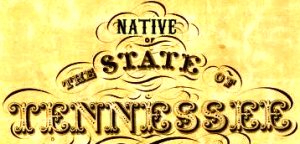
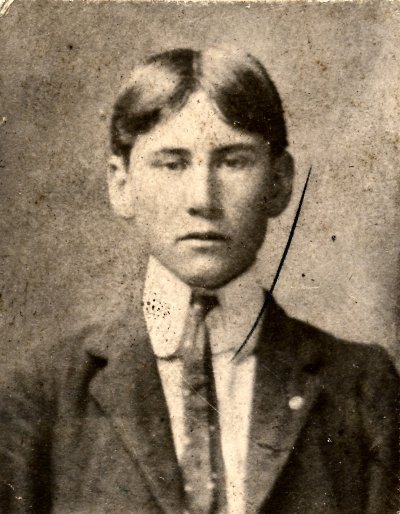
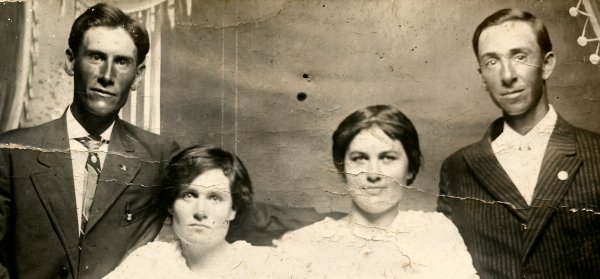
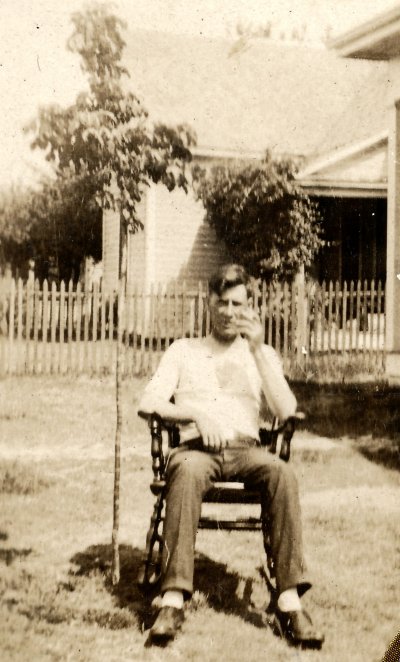

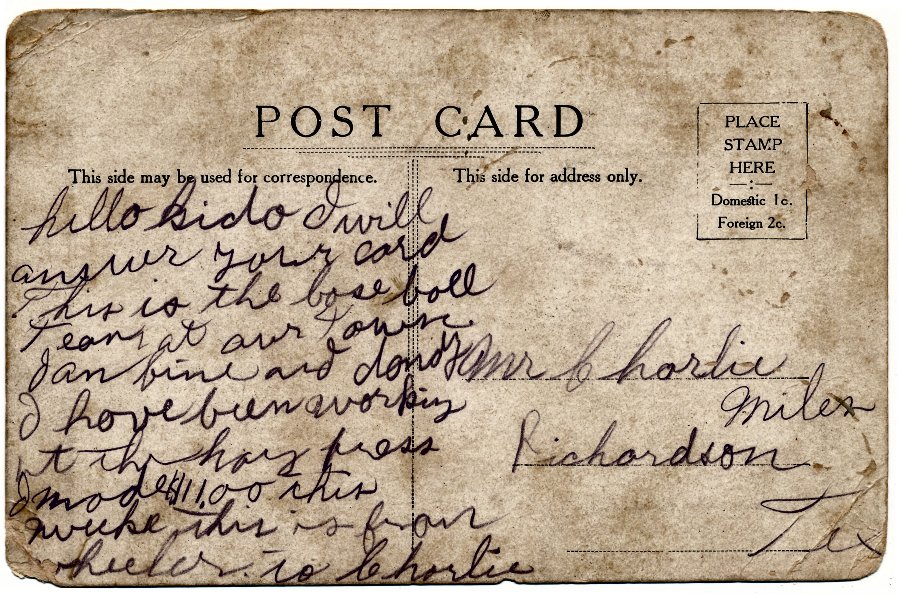
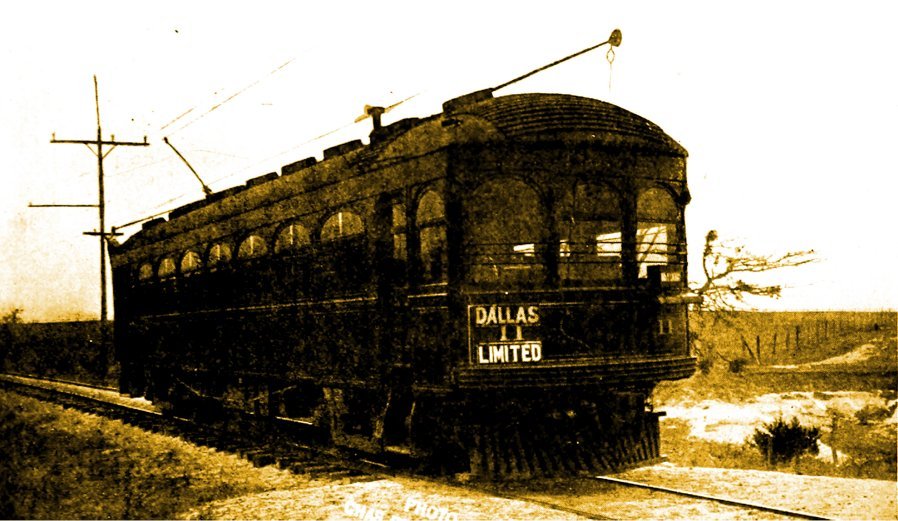
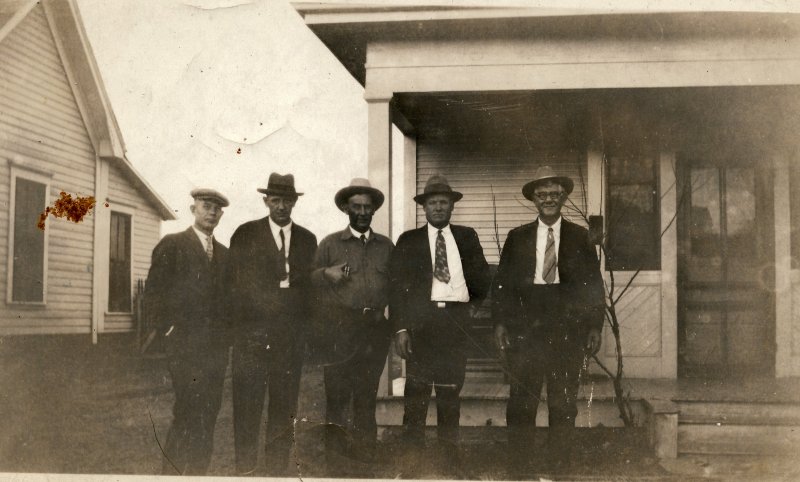
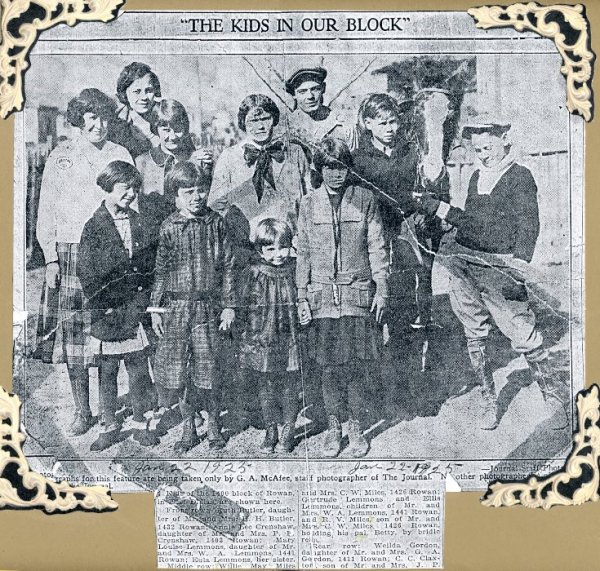
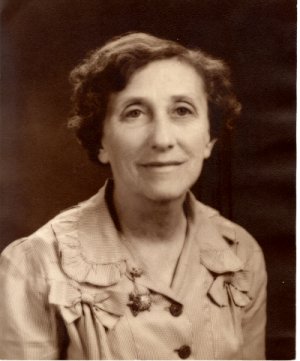 Sometime in March or early April 1927, owing to circumstances that are completely unknown to anyone living today, Charlie W. Miles and his neighbor, Alice Tate Butler (see photo, left), both forty-one-years-old, had a secret, intimate liaison that resulted in Alice becoming pregnant. Whether their relationship took the form of a "one-night stand" or a long-term "love affair" is unknown. Nor is it known whether either of their spouses knew of the affair or liaison.
Sometime in March or early April 1927, owing to circumstances that are completely unknown to anyone living today, Charlie W. Miles and his neighbor, Alice Tate Butler (see photo, left), both forty-one-years-old, had a secret, intimate liaison that resulted in Alice becoming pregnant. Whether their relationship took the form of a "one-night stand" or a long-term "love affair" is unknown. Nor is it known whether either of their spouses knew of the affair or liaison.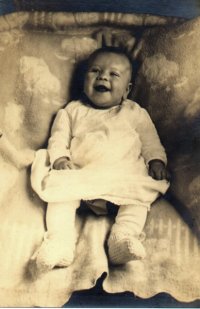 It's easy to understand why Charlie and Alice chose to keep Raymond's paternity a secret. To reveal it would almost certainly have resulted in two divorces and two broken families. It would have also subjected both parties, as well as their child, to the scorn of disapproving family, friends, and neighbors. For Alice, owing to the double standard that then prevailed, the shame and disgrace would almost certainly have been unbearable. Without a husband, she would have been forced to raise Raymond on her own, and without any marketable skills of any kind, the only kind of work she would likely be able to find would have been low-paid and menial.
It's easy to understand why Charlie and Alice chose to keep Raymond's paternity a secret. To reveal it would almost certainly have resulted in two divorces and two broken families. It would have also subjected both parties, as well as their child, to the scorn of disapproving family, friends, and neighbors. For Alice, owing to the double standard that then prevailed, the shame and disgrace would almost certainly have been unbearable. Without a husband, she would have been forced to raise Raymond on her own, and without any marketable skills of any kind, the only kind of work she would likely be able to find would have been low-paid and menial.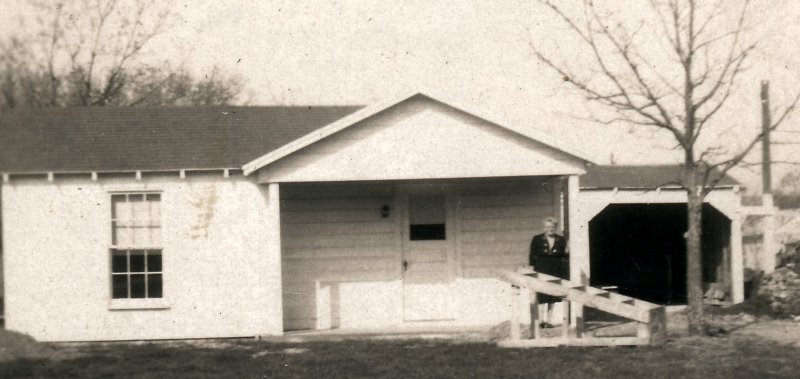
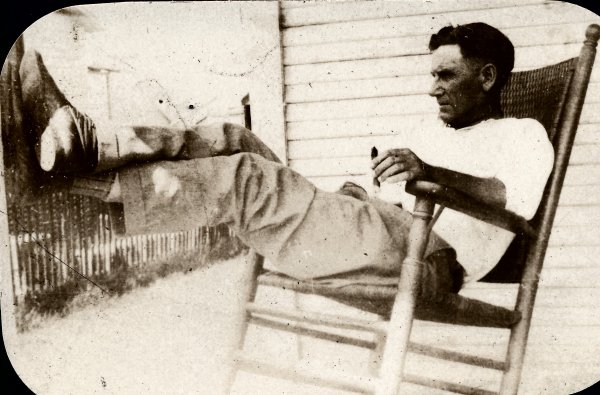
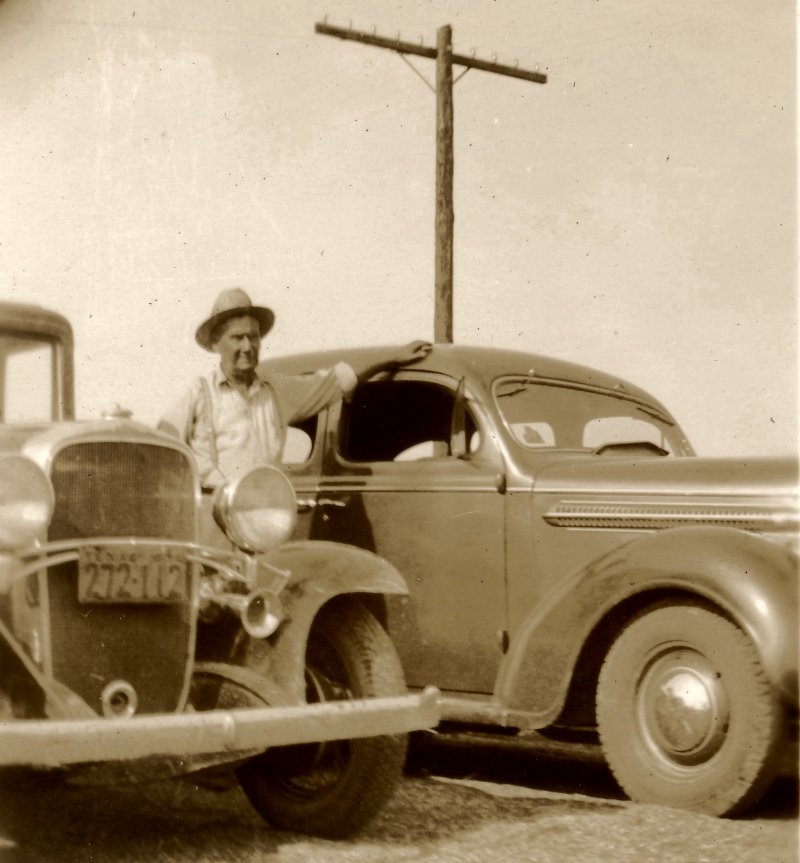
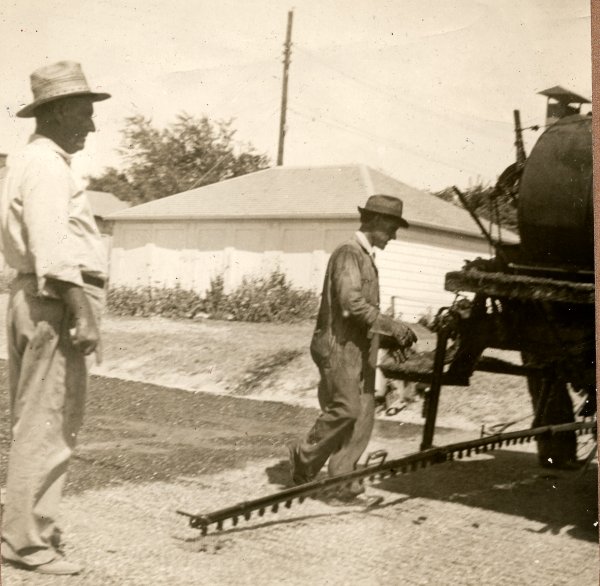
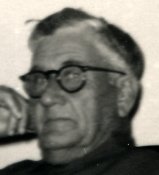 In all likelihood, Charlie Miles retired in 1950, when he turned sixty-five and was eligible to draw social security and possibly also a county pension.
In all likelihood, Charlie Miles retired in 1950, when he turned sixty-five and was eligible to draw social security and possibly also a county pension.